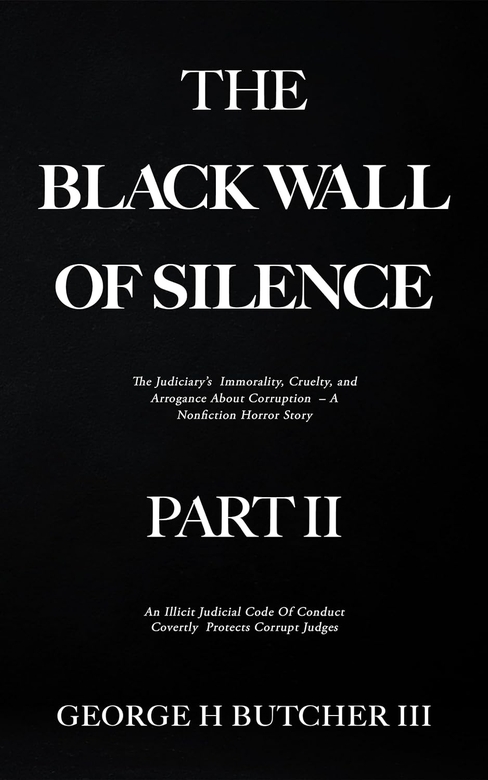
The second installment of an eye-opening “Nonfiction Horror Story,” The Black Wall of Silence Part II: The Judiciary’s Immorality, Cruelty, and Arrogance About Corruption by George H. Butcher III is another relentless dive into the implicit corruption of America’s federal judiciary, including the very highest levels.
This damning indictment gives evidence for a purported secret judicial code of conduct that is used to protect corrupt judges, and the prime beneficiary of this shadowy umbrella of protection is not just the corruption, but the reputation and outsized control of the broader judiciary itself. Butcher explores in detail how federal district court judges and appellate judges have demonstrated corruption in their rulings in relation to other members of the judiciary, choosing injustice to avoid exposure of potential vulnerability to the institution of the judiciary.
The three chapters of this second part pick apart every step of judicial proceedings, while explaining tools and tactics for identifying errors and corruption in other federal proceedings as well. As Butcher continues to show with this second book of the series, the only real efforts made by the federal judiciary to stem the corruption in its ranks are designed to ensure that investigation and prosecution for such corruption are tangled and fruitless.
Many of the well-articulated claims in the book echo similar contemporary conversations about law enforcement, which also demonstrates certain internal protective policies to prevent reform and avoid prosecution for officers who have committed grievous crimes. The functions of law enforcement and the judiciary are obviously tied, due to their proximity to criminality and the doling out of justice, and Butcher’s excoriation of the federal judiciary certainly splashes back on other aspects of society that require intense scrutiny. The recent attention on the ethical blurriness of the United States Supreme Court should elevate the appeal for this series even higher, particularly for those eager to learn how the sausage of justice is made in America.
While the intended audience of the book is the general public, many of the arguments and details are written at a high scholarly level, as the author clearly wants to present his case legitimately. However, as was the case in the first six chapters of this four-part series, inconsistency in the tone of the language undercuts the valuable information being presented. For example, even in the subheadings themselves, the use of colloquial terms like “Con Job” beside other titles wreathed in legalese can feel jarring. The injection of personal feelings regarding the unfairness of the judiciary could be curbed, as well as some of the most impartial language and offhand comments, which make it seem more like a vendetta than a scholarly treatise. With such a compelling case and well-presented evidence of wrongdoing, the added vitriol doesn’t necessarily contribute valuable information to the argument.
That said, the big-picture thesis remains unwavering and convincing: there is a systematic rot at the root of America’s federal judiciary, and it continues to be exploited and allowed to grow unchecked. The author’s righteous anger is at the very least justified, and readers of this thoughtful tome will come out with a different view of contemporary politics and judicial power in America.
Book Links
STAR RATING
Design
Content
Editing
Get an Editorial Review | Get Amazon Sales & Reviews | Get Edited | Get Beta Readers | Enter the SPR Book Awards | Other Marketing Services























Leave A Comment